ATI Eyefinity Ecosystem - September 2010 Update
Just over a year ago, ATI unveiled their Eyefinity technology at a press event on the USS Hornet. The first card - the Radeon HD 5800 - launched at the end of September. We're almost one year out from the initial unveiling and launch, and ATI brought together a handful of media and gaming folks to talk about the current state of the "Eyefinity Ecosystem".
While some of the info (like their market penetration) was a bit of self-promotion (and what company isn't going to promote their success), there was one key announcement - the release of Active DisplayPort to Single-Link DVI adapters into the market.
Single Link Active DP Adapter
The big announcement of the conference call was the release of Active DP > SL-DLI adapters onto the market. While the products had been announced as "coming soon" by manufacturers such as Accell, we were informed that the products would indeed be reaching the market in September.
The new Single Link adapter is made to greatly reduce the cost and complexity of setting up Eyefinity. DP monitors are not needed, and this adapter is much smaller, cheaper and easier to use than the first Dual-Link DVI adapters that were available. Dual-Link DVI adapters are often hard to find, temperamental, and still cost about $100. Many users have trouble with flickering and blanking on their monitors, and even re-branded offerings from the same OEM behave differently.
The new adapter costs just $30, requires no external power, and in testing does not suffer from any of the blanking issues that drove original adopters to passive DP > VGA adapters. Considering the win-win-win of the Single Link Active Adapter, I posed the following Question to Evan Groenke, of AMD's Global Communications division:
A (Evan): "Firstly, the DL-DVI adapters already existed and were available from Apple in miniDP to DL-DVI form, as well as Dell had an adapter available around the launch time of the ATI Radeon HD 5000 series. With adapters already available we worked with the vendors to qualify their firmware with the ATI Radeon HD 5000 Series. Also the spec already has the capability to pass single link DVI outputs passively so at a first glance it is counter intuitive to create active SL-DVI when the spec can do it more cheaply passively. Another factor contributing to this is that the DL-DVI dongle is made from off the shelf ASICs (TMDS transmitter, DP receiver, etc.), whereas the SL-DVI dongle is a single new ASIC that combines all of these functions into a single piece of silicon.
The new demand for active SL-DVI-to-DP adapters really arose because of the way Eyefinity is implemented, so part of it was showing the vendors the demand for such a product to make the adapters in the first place. That could only happen when people had seen the positive reaction to Eyefinity. In essence, the fact that these adapters are here now is tantamount to and as validation of the success of Eyefinity."
Installation
The installation couldn't be simpler. You plug the adapter into the DVI cable, and then plug the DP connector into your video card. If hot plugging while your PC is booted, you need to attach the adapter to the cable first. There are no drivers to load, and it is not dependent on any particular version of the Catalyst driver set. There is also no external power needed.
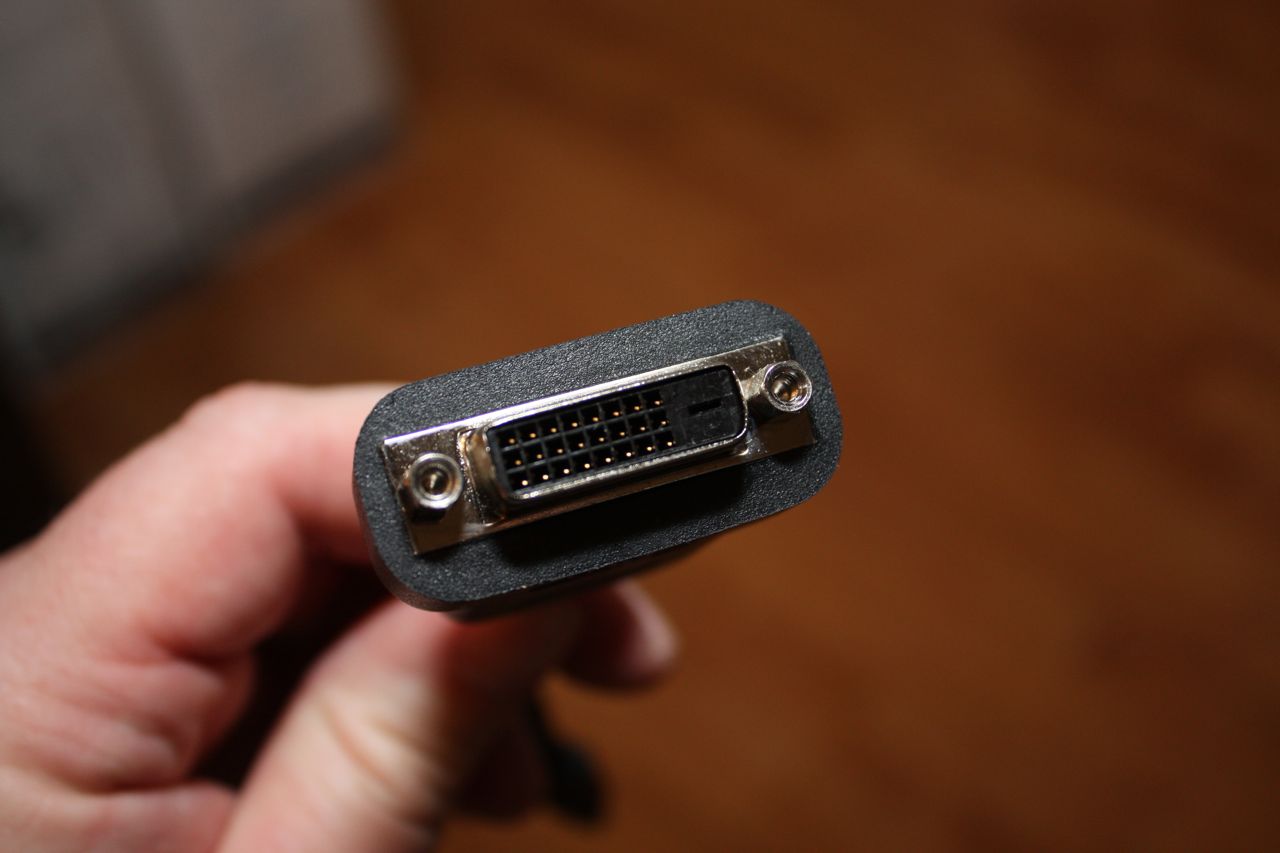
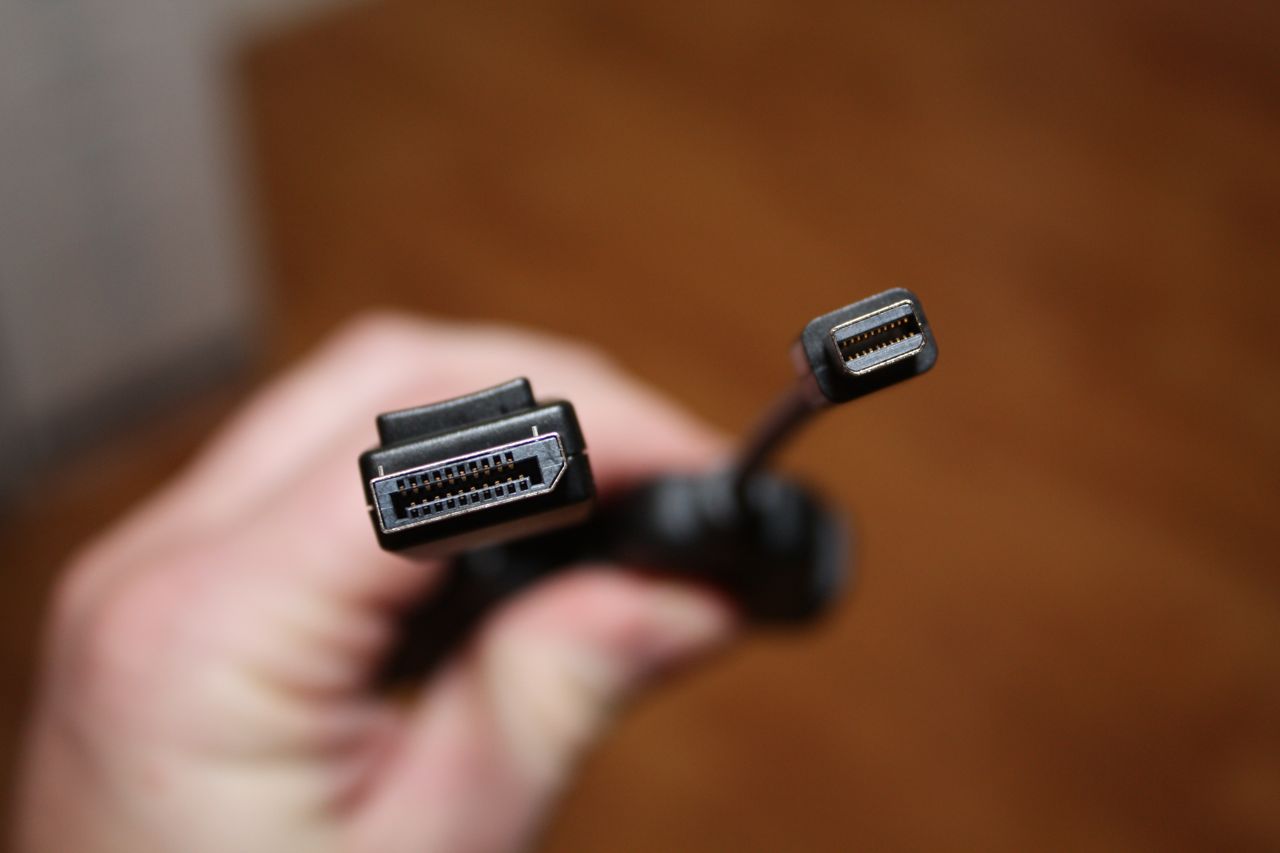

Support
Being a single link device, it support signals up to 1920x1200 at 8-bit color.
Performance
The part just works. I'm running a pair of Eyefinity6 cards in CrossFireX. I am using Mini-DP > DP cables to my five monitors in portrait. I grabbed a DVI cable, and swapped the cable+adapter for my mini-DP cable in the first connector. I booted, and it worked. BIOS screens loaded (it's an electrical adapter - no drivers), as did Windows 7. I swapped resolutions, and ran through five different profiles:
- 5x1-L (Extended)
- 5x1-P (Extended)
- 1-P + 3x1-P (EF Group) + 1-P
- 3x1-P (EF Group)
- HDTV off of port #6.
In the last two configurations the monitor connected to the adapter was off. The adapter had no problem with switching resolutions, configurations or orientations. It also had no problem being taken out of the active profile, and being turned back on. I've never had to use a DP adapters, as I bought DP screens for my Eyefinity rig.
I did have blanking on the 10.3 and 10.4 drivers (so I know what it looks like). But my blanking issues were fixed with Catalyst 10.7 I had no blanking or flickering with any resolution or configuration change. Over reviewers such as Rage3D (see page two) have had similar success.
Availability
The new adapters will be available from manufacturers such as XFX, PowerColor, Wieson, Accell and Sapphire (and more). The parts will be available from online retailers such as NCIX, Memory Express, Micro Center, and Amazon.com (among others).
Additionally, GPU vendors will be including the adapters with certain Radeon 5000 SKUs as part of a bundle. While pricing hasn't been revealed by any of ATI's partners, we expect somewhere between the base price of the board and the additional $30 of the adapter.
Additional Pictures

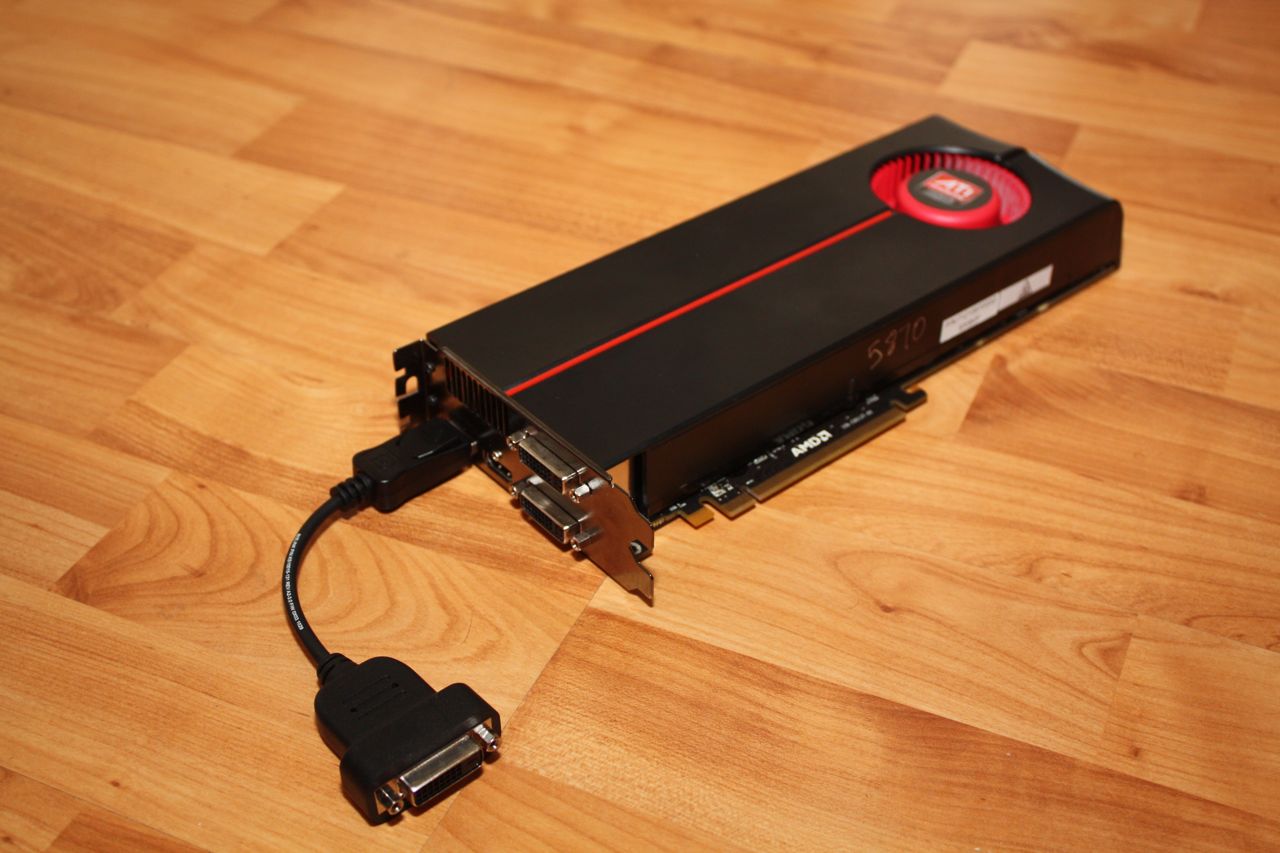
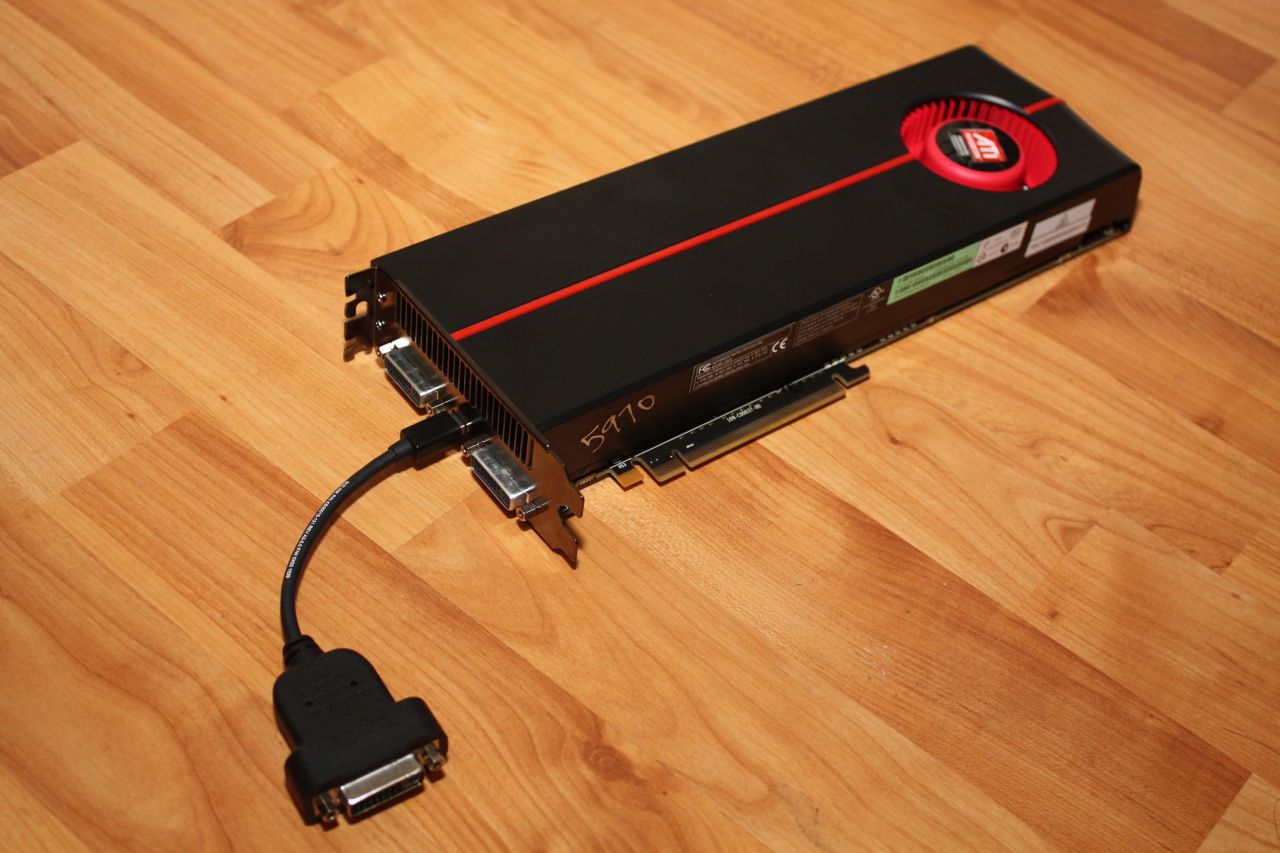
ATI Eyefinity Ecosystem - September 2010 Update
During the call, ATI provided some details as to the success of the Radeon HD 5000 series. While everyone loves a good set of numbers, I think there is a greater take-away. The Radeon HD series as been very successful with ATI, and Eyefinity as a unique feature as been a success as well.
This is good news for gamers of all stripes. The more traction that multi-monitor gaming gets from a hardware standpoint, the better support developers will provide in their games. Over the past year we have seen more and more games have better "basic" support for multi-monitor, and I hope the success of Eyefinity points to even better support in the future.
Penetration of HD 5000 Series
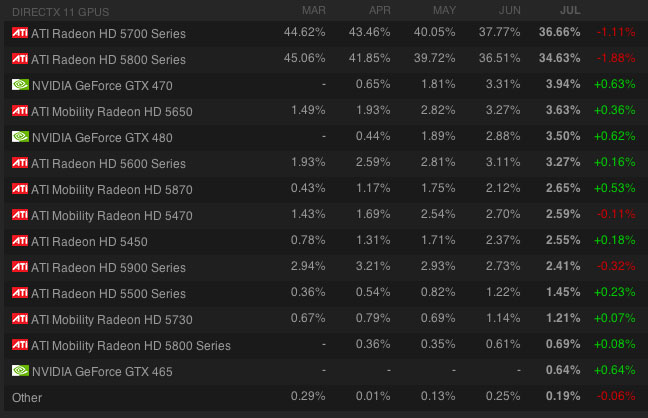 In three quarters, AMD has shipped over 16 million Radeon 5000 SKUs. With each of these supporting Eyefinity, that puts a potentially large user base into the market. Based on these shipments (and the late release of the NVIDIA GTX400 series), ATI now has 51% of the discrete graphics market.
In three quarters, AMD has shipped over 16 million Radeon 5000 SKUs. With each of these supporting Eyefinity, that puts a potentially large user base into the market. Based on these shipments (and the late release of the NVIDIA GTX400 series), ATI now has 51% of the discrete graphics market.
Additionally, looking at the DX11 GPU usage in the Steam Hardware Survey, ATI has a commanding lead with almost 92% of the DX11 install base. ATI obviously jumped out to an early lead in the DX11 space, but NVIDIA will surely begin to recover market share in this newest class with the continued roll-out of its GTX400 series (SKUs like the GTX460 in particular).
However, the leaks around the pending 6000-series should keep things interesting in the GPU leap-frog.
Developer Adoption of Eyefinity
ATI continues to tout growing support of the Eyefinity platform in top tier games. With the release (and continued updating) of the open source Eyefinity SDK, ATI has provided tools to ease developers into supporting Eyefinity and multi-monitor. While much of the much of the SDK is devoted to Eyefinity-specific implementations (based on reading info from an Eyefinity Display Group), the basis of the SDK is universal to any multi-monitor environment. This attitude helps ensure that all gamers benefit from ATI's work, and that no gamers are left without support.
While we've had some disappointments (Mass Effect 2), some games patched late (Bioshock 2), and some games that continue to need fan-made hacks (StarCraft II), ATI has secured strong support from many developers. Support of Eyefinity is a growing trend, and the chart below is a reflection of their current support.

More DP Monitors Available
A year ago DisplayPort monitors were few and far between, and they tended to be larger high-end monitors with matching price tags. Over this past year, DP monitors have become ubiquitous reaching though the upper-end into the mid-range monitors. By way of example, each widescreen monitor in HP's commercial "Advantage" and "Professional" lines has a DisplayPort input. This includes sub-$250 TN models and sub-$300 IPS models. And HP is not alone with this type of DisplayPort adoption, with Dell and Apple offering similar adoption.
AMD Value Proposition
ATI has always billed its Radeon HD 5000 series as a strong value for the price/performance ratio. They made great strides in noise, heat and power consumption over their previous generation, as well as the the offerings from NVIDIA. Eyefinity requires at least one DisplayPort connection, and that adds an inherent cost to the setup as either new monitors or adapters must be purchased.
PC Perspective talked about the price of a multi-monitor setup in their review of NVIDIA 3DVS, and compared the total costs of ATI Eyefinity to NVIDIA 3D Vision Surround (which requires SLI). Lowering the cost of the DisplayPort adapter makes a significant change to the total investment for Eyefinity. Couple this with the mid-range cards released in the last year, and Eyefinity is a significantly better value than it was at launch.
Conclusion & The Future
ATI has done a lot over the last year to promote and improve the value of its Eyefinity platform. Relevant monitors (including IPS monitors) are considerably cheaper, and Active DisplayPort adapters are now significantly cheaper. Mid range cards (HD 5850) are available for under $300, and CrossFireX performance has been solidified so multi-GPU can be had for $500-$600. Add to this that the Radeon 6000-series seems to be around the corner, with the expected HD 6800 SKU performing on par with the HD 5970 multi-GPU card.
I agree with ATI that Eyefinity is a mature platform, and we're about to hit the second generation of the platform with the HD 6000-series. With the newly available Single-Link DVI adapters, the entry price for new Eyefinity users is much lower - as is the potential frustration level. With continued competition with NVIDIA in the multi-monitor space, the future is bright and immersive.